The 2010 MC-252 disaster (Deepwater Horizon spill) caused weathered oil to wash ashore along the north central Gulf coast and impacted estuarine communities of plants and animals. PEBL lab members worked with researchers from the Sarasota Dolphin Research Program based at Mote Marine Laboratory, and scientists from the Florida Fish and Wildlife Research Institute to study the ecological impacts in two connected estuaries in the Florida Panhandle. Our project encompasses Choctawhatchee Bay, Santa Rosa Sound and Pensacola Bay. The two inlets at Destin and Pensacola were impacted by oil slicks, and significant amounts of oil product were drawn into Pensacola Bay during incoming tides throughout the height of the spill. There is still residual oil and tar being found on local beaches and submerged in the bottom sediments, resulting in a lingering exposure to the ecosystem.
The primary goals of this ongoing project are to assess population size and genetic discreteness of oil spill impacted bottlenose dolphin communities in these bays, determine stable isotope and fatty acid signatures to define their feeding habits, and examine the relationship between feeding and trophic interactions in these apex predators as a means to assess the potential impacts of oil and residual contaminants throughout the region. The principal mechanism for assessing contaminant exposure is the collection of tissue samples from wild dolphins using remote biopsy darting. Samples acquired from resident dolphins are used in standard toxicological and enzyme marker assays from the blubber, genetic analysis, stable isotope analysis of skin (to assess feeding ecology and habitat utilization), and fatty acid signature analysis of blubber (feeding ecology). This project also incorporates samples collected from stranded animals by the Emerald Coast Wildlife Refuge, and the ongoing photo-ID work conducted by UCF grad students to identify habitat use and movement patterns of dolphins in this region.
Our small expert team ventured out in a 5.5 m boat during November 2010 and April 2011 to locate and sample select dolphins across the study area. In total, 66 samples were collected (34 in Nov, 32 in Apr) from a variety of sites in each of the estuarine regions on both occasions. The resulting samples were processed and express shipped overnight for analysis at several laboratories.
To date, we have compiled the stable isotope results and compared them to the movement and habitat use patterns of the subject dolphins determined through photo-ID. We are finding significant differences between dolphins that inhabit the inner bays and those found primarily around the inlets at Destin and Pensacola, as well as seasonal differences. Further exploration of these patterns will help determine correlates between movement patterns and dietary compositions, which will be facilitated through comparison to samples of putative prey fish species collected during this period by our colleagues at Florida FWRI. Other sample components (genetics, fatty acid signature, and contaminants) will eventually be analyzed and available for comparison to the stable isotope and habitat use data. Ultimately, pre- and post-spill knowledge of the spatial and temporal scales of these animals’ movements, population structure, specific habitat utilization and feeding preferences will allow interpretation of the toxicological and medical data. Our findings will assist resource managers with understanding the impacts of stressors at all levels of the ecosystem, which can be used to improve response strategies in future environmental disaster events.
